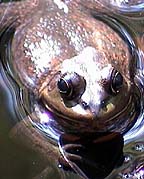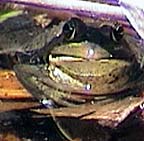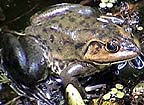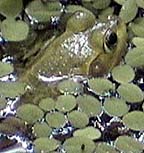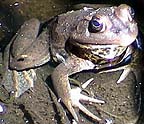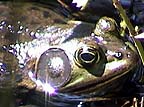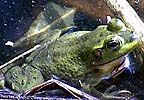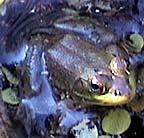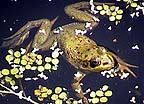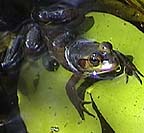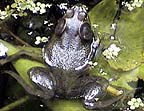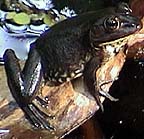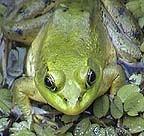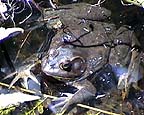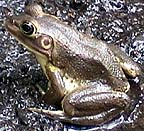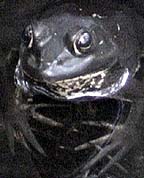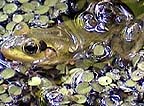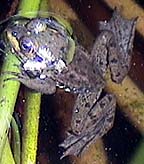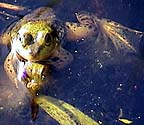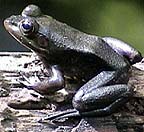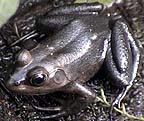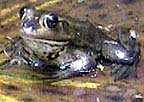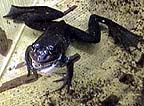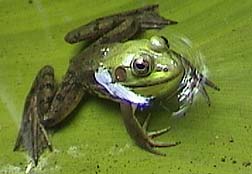
Pig Frog
Rana grylio
Description:
- adult sizes range from 3-1/2 inches to 6-1/2 inches; it is the second largest frog in Florida behind the Bullfrog
- Pig Frogs have narrow, pointed heads (the snout is narrower and more pointed than that of a Bullfrog)
- the hind feet are fully webbed -- webbing on the longest toe extends almost all the way to the tip (top photo); webbing on the longest toe on other large frogs' rear feet stops well before the tip
- the eyes are noticeably elevated above the head and are fairly close together
- colors can vary widely, but almost all have prominent, scattered dark spots on the back
- the belly is whitish but may have dark spots, especially toward the rear
- younger Pig Frogs are usually uniformly dark, but they can sometimes be greenish
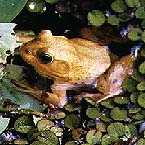 adult Pig
Frog colors range from blackish-brown to an extremely dark olive green
that blends in with mud and tussocks, to bright green, to yellow
adult Pig
Frog colors range from blackish-brown to an extremely dark olive green
that blends in with mud and tussocks, to bright green, to yellow
- genders can be distinguished by the tympanum (outer ear located just behind the eye) -- that of the male is noticeably larger than the eye while that of the female is the same size or smaller than the eye (right column-- male 3rd photo, female 4th photo)
- some males have bright yellow throats
- the thighs also have a light line or a row of light spots running across their rear that other frogs of similar size don't have
Food:
- opportunistic feeders that will eat insects, worms, small amphibians, small crustaceans like snails and crayfish, and small reptiles.
Call:
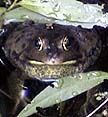 regular
call
regular
call
- sounds like the guttural grunt of a pig
 a
second call sounds like the single plucking of a really large stretched
and taut rubber band (video)
a
second call sounds like the single plucking of a really large stretched
and taut rubber band (video)
- alarm call is a single squeek
Habitat:
- prefer permanent open waters of ponds, streams, lakes, rivers, swamps, and marshes
- may either float in open water or choose a station on or amid floating/emergent vegetation
- much more aquatic in nature than Bullfrogs
Range:
- entire state of Florida, and into southern and coastal South Carolina, Georgia, Alabama, Mississippi, Louisiana, and extreme eastern coastal Texas
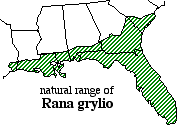
Breeding:
- breeding choruses call from April through the summer
- the choruses usually erupt at night when the vast majority of the mating occurs
- rainy, overcast or humid overcast weather seems to provide conditions that make for active mating
- they breed when the air is humid with temperatures ranging from 63-78 degrees.
- females lay more than 10,000 eggs as a surface film that may adhere to surface or emergent vegetation
- eggs are small and bead-like and are laid in large masses on the surface of the water
- hatching period is 2-3 days; eggs appear to have no animal predators; their only threat is the receding water
- tadpoles in the northern part of the range take more than a year to metamorphose while those in the southern Florida develop in considerably less time
- tadpoles are quite large (100mm), with extremely long tails
- mature tadpoles are colorful with yellow bellies with prominent reticulation on brownish black. Their sides have yellow spots that are encircled by a pinkish color. From the throat region to the pectoral region is clear black and across the pectoral region is green. The yellow spots surrounded by pink continue down the tail in various patterns (Wright 1932)
- after transformation, young frogs remain in the same habitat as adults
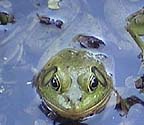 Classification:
Classification:
- Kingdom: Animalia
- Phylum: Chordata
- Subphylum: Vertebrata
- Class: Amphibia
- Order: Anura
- Family: Ranidae
- Genus: Rana (from Latin rana for frog)
- Species: grylio (from Greek gryllos for pig)
- Phylum: Chordata
All photos ©2002-2003 Dick Brewer and taken in the wild (which is where all frogs belong).
Sound ©2003 Ralph Arwood
